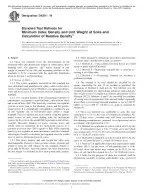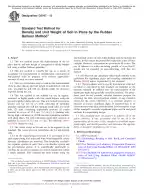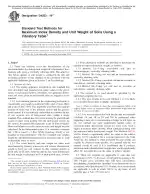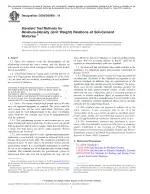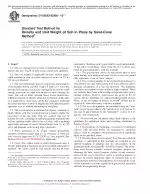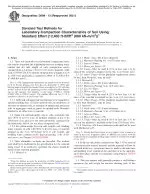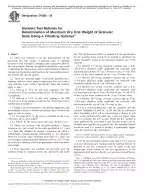ASTM D4254-16 PDF Download
Standard ENStandard Test Methods for Minimum Index Density and Unit Weight of Soils and Calculation of Relative Density
Also Known As:
ASTM D4254-16 is a standard that provides test methods for determining the minimum index density and unit weight of cohesionless, free-draining soils. The standard emphasizes that the dry density/unit weight of a cohesionless soil alone does not indicate whether the soil is loose or dense. In order to interpret the dry density/unit weight accurately, it needs to be viewed in relation to the range of variation in terms of relative density/unit weight. The relative density/unit weight indicates the degree of compactness of the soil with respect to its loosest and densest condition, as defined by standard laboratory procedures.
The standard acknowledges that the test methods have a high degree of variability, but this can be minimized through careful calibration of equipment and adherence to proper test procedures and techniques. The standard recommends the use of standard molds for most soils requiring minimum index density/unit weight testing. However, special molds may be used in cases where there is not enough soil to use the standard molds. It is important to exercise caution when using test results obtained with special molds, as they may not agree with results obtained using standard molds.
The standard also provides information on the system of units to be used, which is the gravimetric or inch-pound system. It explains that density is the mass per unit volume, while unit weight is the force per unit volume. The standard specifies three alternative methods for determining the minimum index density/unit weight, each with its own unique procedures. The method to be used should be specified by the agency requesting the test, and if no method is specified, Method A is the preferred procedure.
The standard is applicable to soils that may contain up to 15% by dry mass of soil particles passing a No. 200 sieve. Method A is applicable to soils where 100% of soil particles pass a 3-inch sieve and may contain up to 30% of soil particles retained on a 1 1/2-inch sieve. Method B is applicable to soils where 100% of soil particles pass a 3/4-inch sieve. Method C is applicable only to fine and medium sands where 100% of soil particles pass a 3/8-inch sieve and may contain up to 10% of soil particles retained on a No. 10 sieve.
| Descriptors | dry density, relative density, unit weight, cohesionless soils,Coarse-Grained Soils,Density and Relative Density,MassCOMMA Volume and Weight |
| ICS Codes | 93.020 - Earthworks. Excavations. Foundation construction. Underground works |
| Language(s) | English |
| File Size | 235.5 KB |

